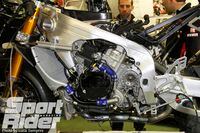In an ever-changing world of technology, WSBK is no exception. Regulatory updates for 2015 have just been released, but there is more to come. In particular, regarding frames. Compared with MotoGP, Superbike has less flexibility in terms of chassis, as it cannot utilize many prototype components. This of course has not prevented manufacturers from making "adjustments" to improve performance. However, the possibility to tweak the chassis (especially in terms of geometry) is likely to be drastically reduced in the near future.
Current regulation (art. 2.4.10.1) states that, "the main frame must be as originally produced by the manufacturer for use on the homologated motorcycle." The only allowed modification consists of adding gussets or tubes to modify stiffness. The engine position and suspension linkage mounting points cannot change, while steering angle and swingarm pivot can be modified within a few millimeters of tolerance. In the past, this has led to rumors (and reciprocal accusations between teams) of against-the-rules chassis adjustments, but it was difficult to measure any hypothetical alterations accurately. At least until next year.
In Donington Park (UK), the newly appointed Technical Director Scott Smart has performed a random test on chassis from Honda, Kawasaki, Suzuki and Aprilia to (successfully) ensure adherence to the rules. "We've used a 3D measuring arm and test software to understand how quickly we can make those measurements with teams," Smart said. "We're planning on customizing the software with our suppliers to be able to perform those checks in 5-10 minutes, with a degree of accuracy of 0.003 millimeters."
To this end, the only issue is that the currently homologated design have much higher tolerances than the measuring machines. "The angle of the steering head and mounting points for both the engine and swingarm consider rather ample value oscillations," former Aprilia engineer Jan Witteven observed. "Lower tolerances are required to resemble more accurately the production models, and also because a higher flexibility only favors factory teams, which can bring different chassis based on the riders' preference and tracks' layout."
"Currently, the tolerance on drawings is massive," Smart agreed. "We have reached an informal agreement with teams to remove or reduce the tolerance on any specified dimension next year." Updated regulations, increasingly aligned to the cost-cutting policy introduced by Dorna, should be released soon.

/cloudfront-us-east-1.images.arcpublishing.com/octane/EFFSPCZVBBCMTNGVEQMB7NNKIU.jpg)
/cloudfront-us-east-1.images.arcpublishing.com/octane/5GP3PUGFKVGUVCEYG4ZBDYLNBE.jpg)
/cloudfront-us-east-1.images.arcpublishing.com/octane/USTSFGXT3ZGL7BT7B66WMSSKTI.jpg)
/cloudfront-us-east-1.images.arcpublishing.com/octane/Z7YU6FSR6NEKVMKT5CZPMKIVLE.jpg)
/cloudfront-us-east-1.images.arcpublishing.com/octane/MOP35BTV3FFANFBUJKU2RJRTZ4.jpg)
/cloudfront-us-east-1.images.arcpublishing.com/octane/UWTN4NTIJFD25MPXBOVS4DFOXE.jpg)
/cloudfront-us-east-1.images.arcpublishing.com/octane/SIFOY54XMFGEHAUYNFUYVW7IZ4.jpg)
/cloudfront-us-east-1.images.arcpublishing.com/octane/HMC5X3JZHRASXGVCVNBJBWWGSI.jpg)
/cloudfront-us-east-1.images.arcpublishing.com/octane/UIWGXRZDM5HZXJOWXET2DZIWJE.jpg)
/cloudfront-us-east-1.images.arcpublishing.com/octane/QSS5DZ6SKJEU3AKE4KDAWYBEFY.jpg)
/cloudfront-us-east-1.images.arcpublishing.com/octane/SMCEQCLWRVEFTJJES6TAHB3OOQ.jpg)
/cloudfront-us-east-1.images.arcpublishing.com/octane/JCACIDCAC5FUNPTXO2BOUHGGII.jpg)
/cloudfront-us-east-1.images.arcpublishing.com/octane/DC7ZGILA2BCJXHZIUNYGV7JSEA.jpg)
/cloudfront-us-east-1.images.arcpublishing.com/octane/EWJEZUGWEZGABDEQWB64WL46GQ.jpg)
/cloudfront-us-east-1.images.arcpublishing.com/octane/5NHBMRMSFVD5JAPFNMBMNPGXQE.jpg)
/cloudfront-us-east-1.images.arcpublishing.com/octane/WHE43SCPLJBRNANAJAGXHOAIEU.jpg)
/cloudfront-us-east-1.images.arcpublishing.com/octane/6R56AQAW6NDE7BBIJ3SMCOOY5A.jpg)
/cloudfront-us-east-1.images.arcpublishing.com/octane/JMQTUE2FKZFURJTJXDMM4V47AQ.jpg)
/cloudfront-us-east-1.images.arcpublishing.com/octane/P2QYJDMQNVEANMQFXHNB3OVFKQ.jpg)
/cloudfront-us-east-1.images.arcpublishing.com/octane/VNKGXM4AA5BPRGERJOPV6GADAQ.jpg)
/cloudfront-us-east-1.images.arcpublishing.com/octane/2WS4YIFLTNG25L25WP7ZFLSWJM.jpg)
/cloudfront-us-east-1.images.arcpublishing.com/octane/UXRS6ZVQZFC23FY2EDYNT5WMVA.jpg)
/cloudfront-us-east-1.images.arcpublishing.com/octane/7JETMCKNVRGDZIGB3JCITGLPUU.jpg)
/cloudfront-us-east-1.images.arcpublishing.com/octane/OZV6E2KNIJDVHGOKXQQ2AHKLHQ.jpg)